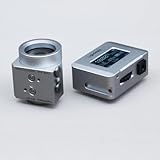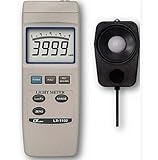Still bracketing and chimping to tame your strobes and LEDs? A good Sekonic L-308X-U Flashmate Light Meter (401-305) ends the guesswork—locking in consistent exposure, predictable lighting ratios, and faster setups whether you’re dialing a key/fill split in studio or matching practicals on a cine set.
In this 2025 guide, we analyzed nine light meters and ranked them for accuracy, repeatability, flash and ambient capability, cine-readout options, ergonomics, and value. You’ll see why Sekonic’s L-308X-U Flashmate tops our list at 76/100 (with the L-308X variant close behind at 64/100), and how they compare to budget lux meters from LATNEX, Ace Instruments, LightNova, and INSTRUKART—useful for lighting design and LED balancing, but not always ideal for incident/flash exposure. By the end, you’ll know exactly which meter fits your workflow (stills or video), what features matter for your use case, and where to find current pricing and availability.
When you buy through links on our site, we may earn a commission at no cost to you. We evaluate products independently. Commissions do not affect our evaluations. As an Amazon Associate, we earn from qualifying purchases.
Top Picks
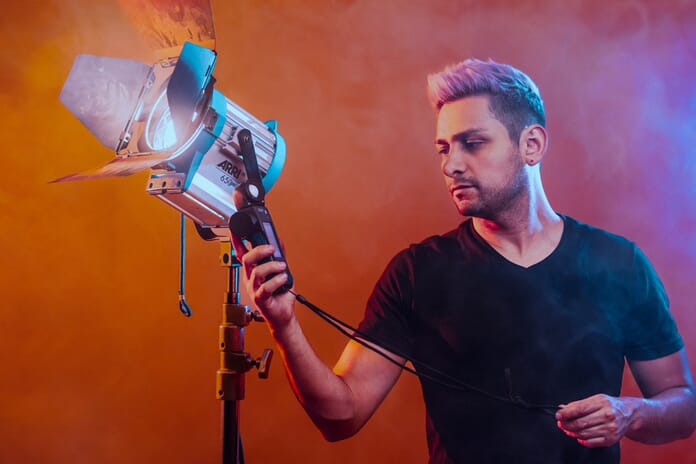
Light Meter Showdown 2025: 9 Pro-Ready Picks for Pinpoint Exposure
| Specifications | |||||||||
|---|---|---|---|---|---|---|---|---|---|
| Rating | 76/100 | 64/100 | 60/100 | 59/100 | 54/100 | 53/100 | 53/100 | 51/100 | 44/100 |
| Meter Type | Exposure meter (flash/ambient) | Exposure meter (flash/ambient) | Digital lux/foot-candle meter | Digital lux meter | Exposure meter (ambient) | Digital lux meter | Digital lux meter | Digital lux meter | Digital lux meter |
| Flash Metering | Yes | Yes | No | No | No | No | No | No | No |
| Measurements/Units | Exposure (photo) | Exposure (photo/cine) | Lux and foot-candle (lx, fc) | Lux (0–400,000 lx) | Exposure (photo) | Lux (0–400,000 lx) | Lux | Lux (0–400,000 lx) | Lux |
| Year | 2018 | 2018 | 2018 | 2021 | 2025 | 2021 | 2024 | 2021 | 2022 |
| Calibration Certificate Included | N/A | N/A | Yes | Yes (Factory) | N/A | Yes (Factory) | Yes (Factory) | Yes (Factory) | Yes (Factory) |
Sekonic L-308X-U Flashmate Light Meter (401-305)
Serious amateurs and emerging pros who need a compact, accurate incident/flash/cine light meter for studio portraiture, product/fashion work, location shoots and basic videography.
- Accurate to 1/10-stop for ambient and flash — reliable precision for exposure and lighting ratios.
- Cine/HD Cine modes — useful for videographers wanting frame-rate/shutter-angle control.
- Compact, well-priced for the capability ($239) with strong user ratings and high sales momentum.
- Not as feature-rich as higher-end Sekonic models (limited connectivity/advanced metering features such as wireless control or built-in logging).
- Flash measurement shutter range limited compared with some pro meters (1 sec to 1/500 sec for flash).
The Sekonic L-308X-U is a good fit for photographers and videographers needing precise ambient and flash exposure readings. It offers dedicated photo and cine modes, making it reliable for studio and location work.
Struggling with inconsistent exposure? Sekonic L-308X-U Flashmate Light Meter (401-305) lands at #1 in our lineup because it delivers repeatable results with pro-level precision and a solid 76/100 performance score. You get accuracy down to 1/10 stop in a compact, pocketable tool that speeds up your lighting workflow.


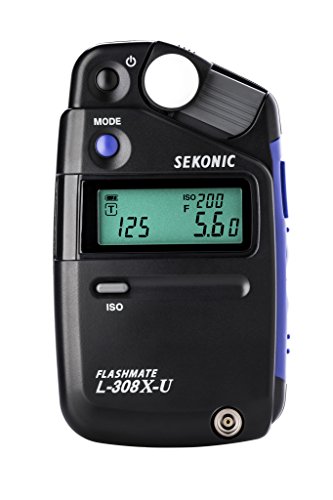
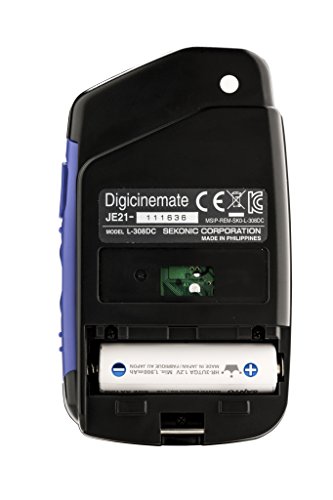
Dialing in lighting ratios is fast and reliable, whether you’re balancing strobes with window light or matching multiple modifiers on a portrait set. Ambient, corded, and cordless flash readings translate to cleaner skin tones, crisp product highlights, and fewer retakes. You’ll see the exact f-stop or shutter value you need, so you can shoot with confidence.
If you’re building a small studio, shooting headshots, fashion tests, or e-commerce, this model makes it easy to set consistent key/fill/hair light levels. It’s also great on location—meter a backlit scene, then pop a test flash and lock in exposure that matches your creative intent. Working at standard sync speeds up to 1/500 is effortless.
Creating video content too? HD Cine and Cine modes let you meter using frame rates and shutter angles, so interviews, B-roll, and commercial pieces maintain proper motion and exposure across shots. At just a few ounces, it slips into any kit and runs on easy-to-find AAA batteries, giving you reliable performance without bulky gear.
With a $239 price, strong user ratings, and proven results, this pick offers excellent value for serious shooters. If you want cleaner files, faster setups, and fewer surprises on set, add it to your bag and level up your lighting control. It’s an easy, confidence-building upgrade for your next shoot.
Sekonic FLASHMATE L-308X Photographers and Film Makers Exposure Meter – Black/Blue
Serious amateurs and emerging pros who want a reliable, portable meter for studio portraits, location flash/ambient control, and basic cine/HD exposure work.
- Compact, pocket-sized and very portable — great for location work and quick scouting.
- Accurate ambient and flash metering with dedicated Cine and HD Cine modes.
- Wide metering range, lux/foot-candle readout and simple sliding lumisphere — reliable, easy-to-use tool for measuring both incident and reflected light.
- Feature set is more consumer/upper-entry level — lacks advanced spot metering, tethering/Bluetooth, and the expanded flash functionality of higher-end Sekonic models.
- Price in the provided data ($681.59) looks high for this model relative to alternatives; value may be questionable for buyers in this market.
The Sekonic FLASHMATE L-308X is a reliable choice for those valuing speed and simplicity in a portable meter, though it lacks some advanced features of pro-grade meters.
Want faster, cleaner exposures on every shoot? This Sekonic FLASHMATE L-308X Photographers and Film Makers Exposure Meter – Black/Blue lands at #2 in our lineup with a 64/100 score thanks to its dependable accuracy, simple controls, and hybrid photo/video versatility. If you value speed and consistency, it’s an easy win to keep in your bag.


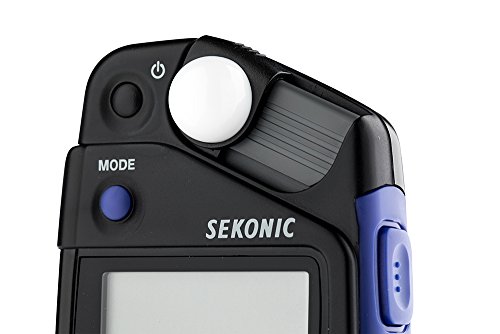
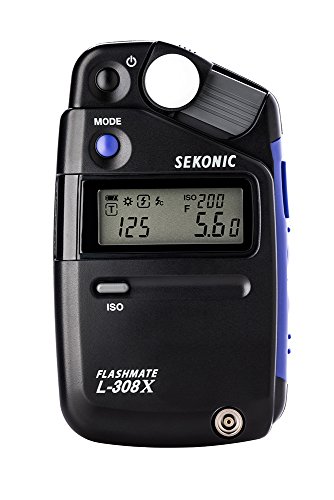
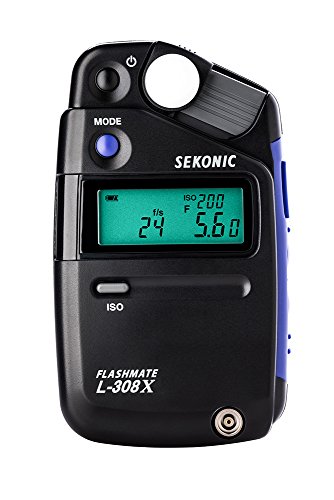
Slide the dome to switch between incident and reflected readings, then lock in exposure in seconds—whether you’re in a dim studio or harsh midday sun. Its broad range handles everything from tiny speedlights to powerful strobes, so you can match ratios and nail skin tones with confidence. You’ll spend less time guessing and more time creating.
Shooting portraits with two or three lights? Dial in your key, fill, and background quickly, or balance window light with flash for natural-looking results. When filming interviews or product videos, Cine and HD Cine modes let you set exposure by frame rate and shutter angle for consistent clips across scenes.
Need real numbers on set? Lux and foot-candle readouts give you precise targets for cinematography standards, while the backlit display and featherweight build make it effortless to use on location. A single AA keeps it running, and the quick operation pays for itself in faster setups and fewer retakes.
If you want a reliable, portable meter that delivers pro-level consistency without fuss, this choice is for you. As our #2 pick, it offers excellent value for serious shooters building a studio kit or stepping into video work. Add it to your kit and start lighting with confidence.
LATNEX Light Meter LM-50KL Measures Lux/Fc – LED/Fluorescent, Industrial, Household, and Photography – Calibration Certificate Included
Serious amateurs who need a reliable, affordable lux meter to check ambient/studio illuminance, lighting uniformity, or fixture performance.
- Accurate broad-range lux/foot-candle measurement (200–200,000 lux) suitable for assessing ambient/studio illuminance.
- Includes calibration certificate and a 1.5 m remote sensor — useful for metering fixtures or hard-to-reach positions.
- Good value at ~$130 — solid price/performance for technical users on a budget.
- Not a dedicated photographic incident/reflective light meter — lacks an incident dome and direct EV/aperture/shutter/ISO conversions.
- Cannot directly measure flash peak output or sync timing (no flash metering), limiting utility for strobed studio work.
The LATNEX LM-50KL is a good value for those needing a reliable lux meter for ambient light checks, though it lacks features for detailed photographic metering.
Want a simple way to keep your lighting consistent? The LATNEX LM-50KL lands at #3 in our lineup with a 60/100 score because it delivers accurate ambient readings at a friendly price. If you need dependable numbers fast, this pick gets it done.

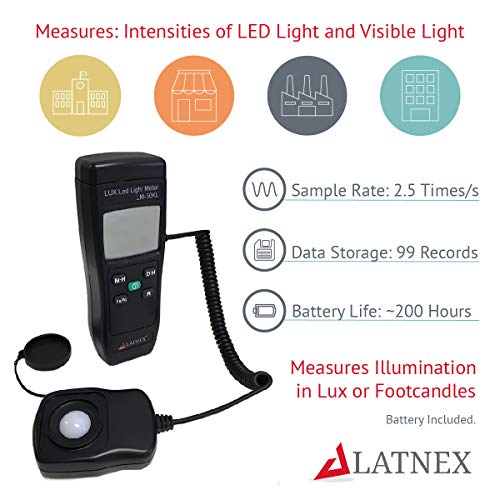
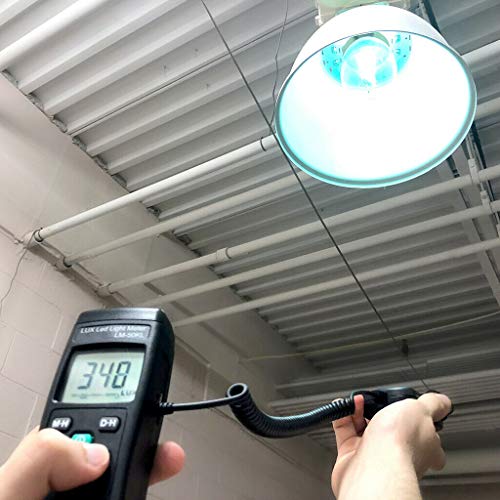
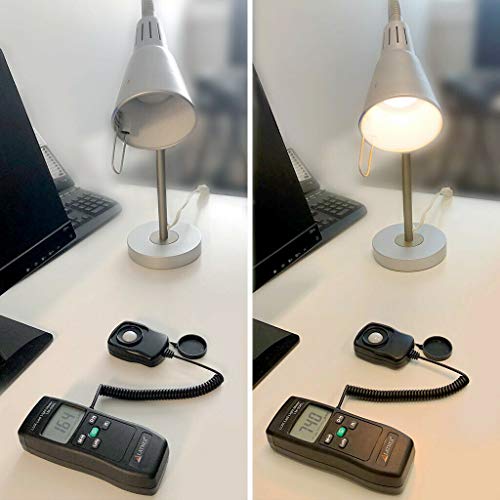
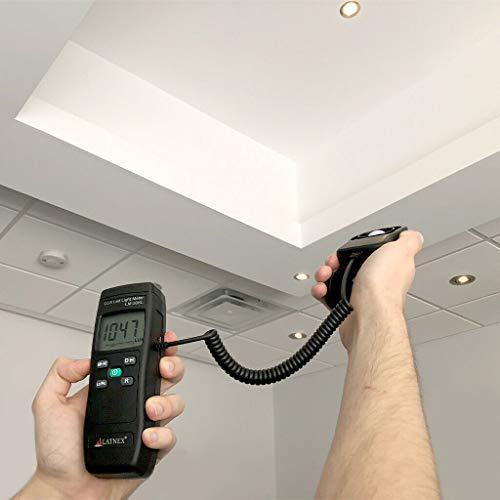
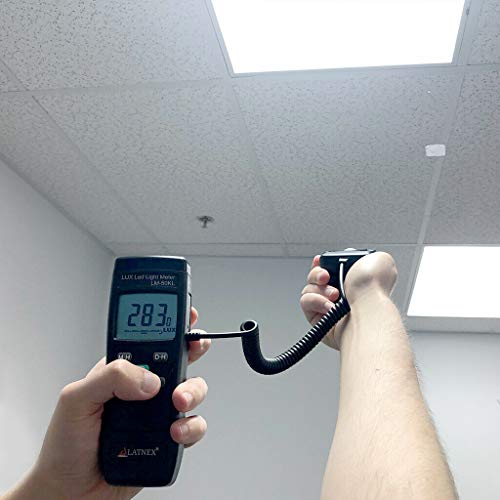
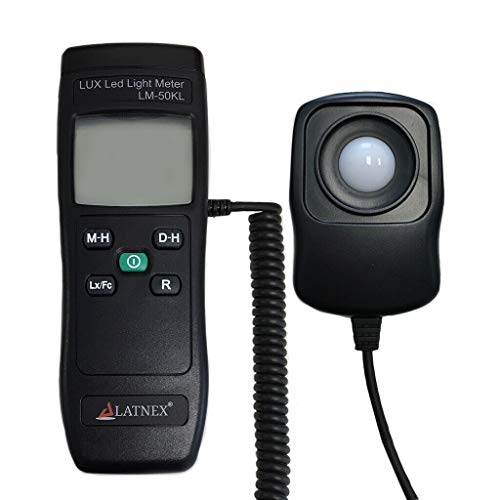
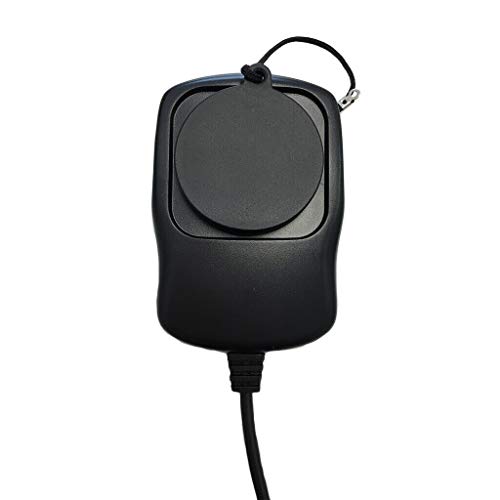
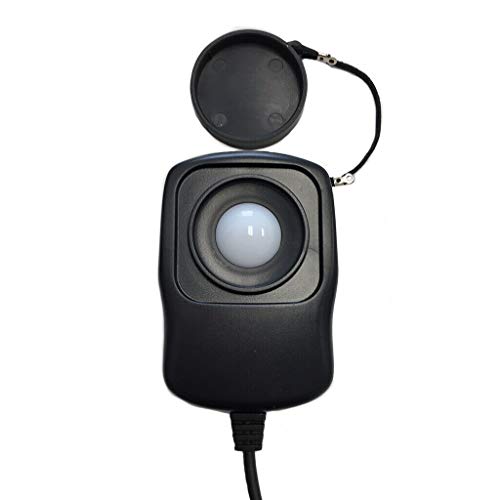
With a wide 200–200,000 lux range and a calibration certificate, you can trust the readings when scouting locations or dialing in a home studio. The 1.5 m remote sensor lets you place the head at the subject, on a stand, or inside a softbox while you read the display, making tweaks quick and repeatable.
Perfect if you want to balance key and fill, match rooms for continuity, or verify LED panel output before a client arrives. Use it to set interview levels, check daylight vs practicals for real estate video, or ensure product shots are lit evenly across a tabletop.
A backlit screen, data hold, and roughly 200 hours of battery life keep you moving on set and in the field. At around $130, plus a carry case and a 1-year warranty, this model offers strong value that pays for itself in faster setups and fewer exposure surprises.
If you want an affordable, trustworthy way to quantify your lighting, add this choice to your kit. It’s a reliable companion for serious amateurs and emerging pros who want consistent results without overspending.
Digital Lux Meter Exposure Meter Alongwith Factory Calibration Certificate (Range: 0 to 4,00,000 Lux) for Auditoriums, Theatres, Stadiums, Labs
Lighting technicians, venue/architectural lighting checks, and photographers/videographers who need a supplemental lux/foot-candle meter for assessing ambient/continuous light in large spaces.
- Wide measuring range (5 to 400,000 lux) — useful for very bright conditions and large venues.
- Factory calibration certificate included — indicates traceable calibration on delivery.
- Data output (RS-232) and memory (max/min) — handy for logging and basic data workflows.
- Not a photographic/flash exposure meter — no incident dome, no flash sync/flash EV readout, no per-stop/aperture/shutter/ISO conversions.
- No spot-metering or reflected-light modes that photographers/cinematographers expect.
This Ace Instruments Lux Meter is a solid, budget-friendly option for venue and ambient-light measurement, though not a substitute for dedicated photographic or cine light meters.
Need quick, trustworthy ambient readings before you roll? This Ace Instruments Digital Lux Meter lands at #4 in our lineup with a 59/100 score thanks to its huge measuring range, calibrated accuracy, and fair price. It’s a smart, lightweight tool that speeds up pre-light checks for serious shooters.
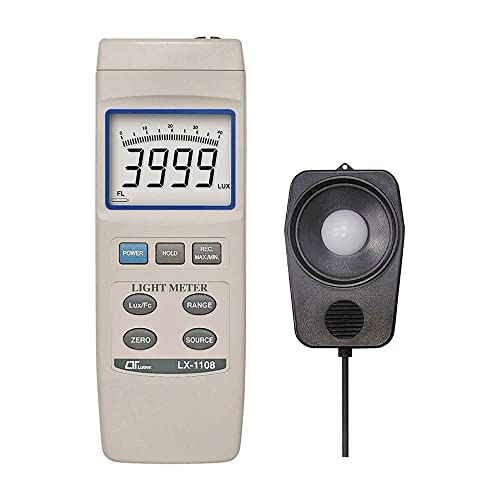
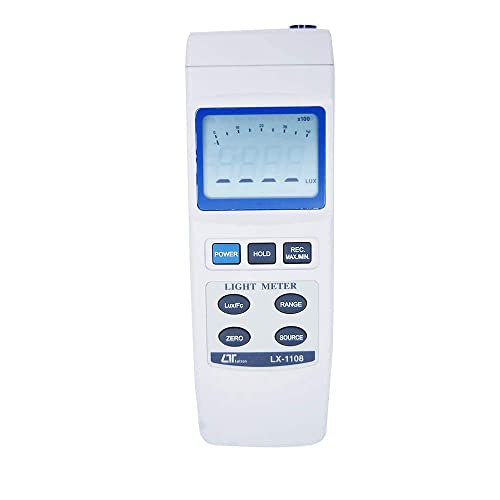
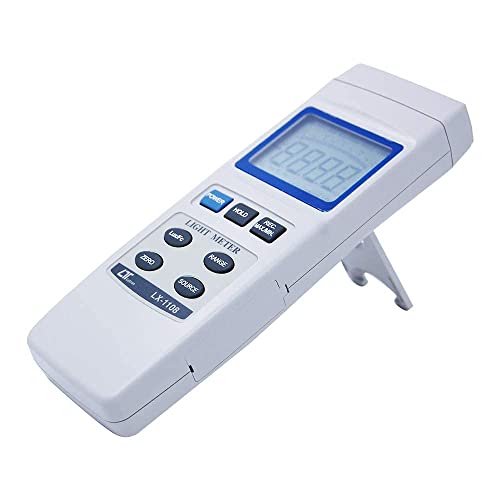
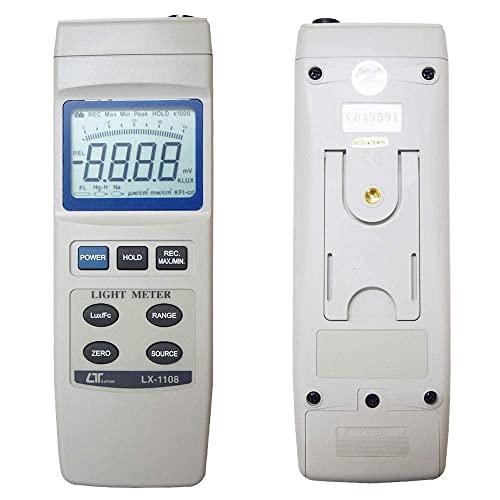
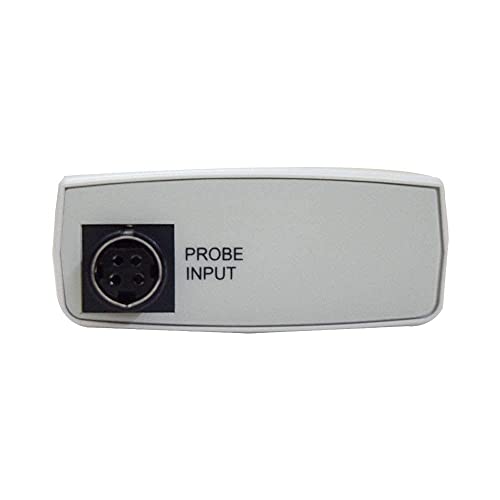
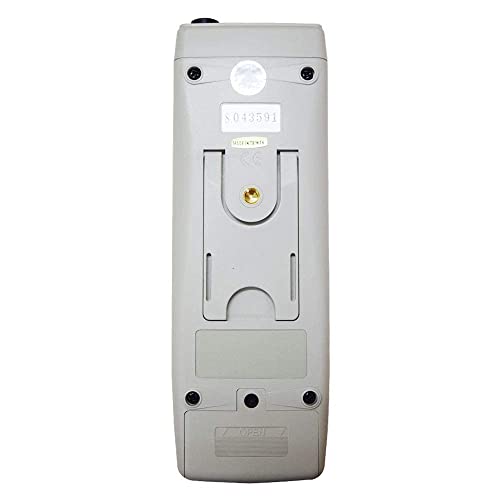
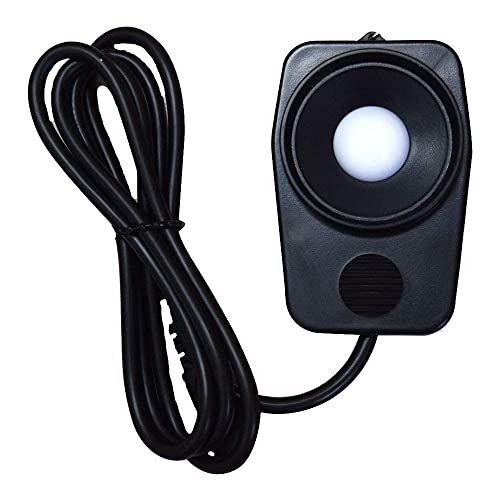
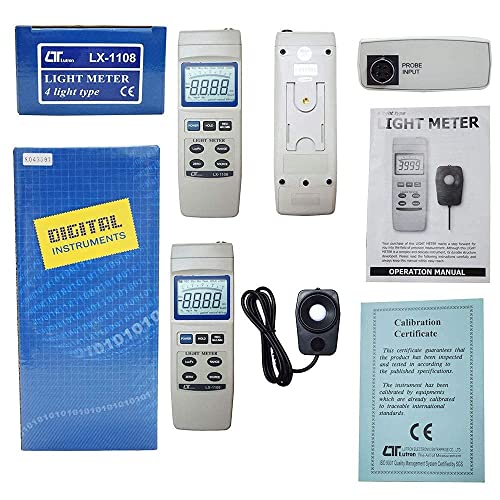
From dim rehearsal rooms to sunlit stadiums, the 5–400,000 lux span lets you measure it all with confidence. CIE cosine correction and lamp-type selection (tungsten, fluorescent, sodium, mercury) help you get accurate numbers across mixed sources, and the large LCD with bar graph makes trends easy to see on the spot.
If you’re scouting auditoriums, planning event coverage, or balancing practicals for interviews, this option gives you fast lux/foot-candle data so you can dial in exposure and ratios efficiently. It’s perfect when you want to quantify daylight through windows, verify house-light levels, or keep consistency across multiple locations for client work and social videos.
A factory calibration certificate adds traceable credibility—useful when you need to show clients or venues reliable measurements. Max/min memory, peak/data hold, and RS-232 output let you log changes, create repeatable setups, and slip readings into your workflow, all in a 220 g handheld that runs on a simple 9V battery. At about $162, it delivers dependable measurements without stretching your budget.
Bottom line: add this pick as a supplemental tool for ambient and continuous-light planning, and you’ll move faster with fewer exposure surprises. If you often work in large venues or architectural spaces, this model offers strong value and pays for itself in smoother pre-production.
LightMate Area 2S Light Meter Photography & OV-X1 17° Retro Viewfinder, 0.96″ Large OLED Screen, Ultra-Compact, Rechargeable Battery, for Leica & Other Film Cameras, Sliver
Serious amateurs or film photographers who want a compact, inexpensive reflected spot meter or a secondary/backup meter for travel and manual-exposure work.
- Compact, lightweight design with a 0.96″ OLED — easy to carry as a spot-metering backup or travel meter.
- 17° OV-X1 retro viewfinder and vfPort interface — gives a true spot/aiming option that film shooters will appreciate.
- Flexible metering modes (single, continuous, average) and switchable aperture/shutter step increments — useful for manual-exposure workflows.
- No obvious incident-dome accessory or incident metering mode — limits usefulness for studio lighting and accurate flash/ratio balancing.
- No mention of flash/TTL/flash-sync metering or dedicated flash mode — a major gap for wedding/portrait shooters and strobed studio work.
The LightMate Area 2S is ideal for film photographers needing a compact spot meter, though it lacks features for comprehensive photographic metering.
Want pocket-size control over exposure for your manual and film bodies? The LightNova LightMate Area 2S lands at #5 in our lineup with a 54/100 score because it blends a true aiming viewfinder, a crisp OLED screen, and thoughtful metering modes in a tiny tool that’s easy to carry. At $129, it’s a smart way to add reliable readings to your kit without overspending.
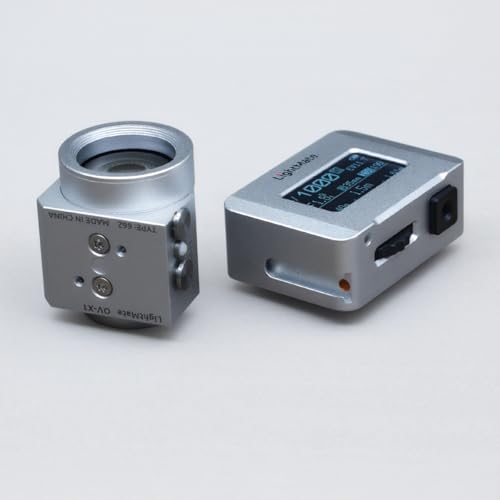
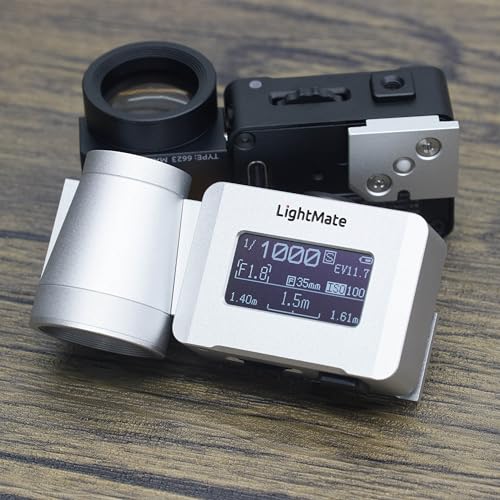
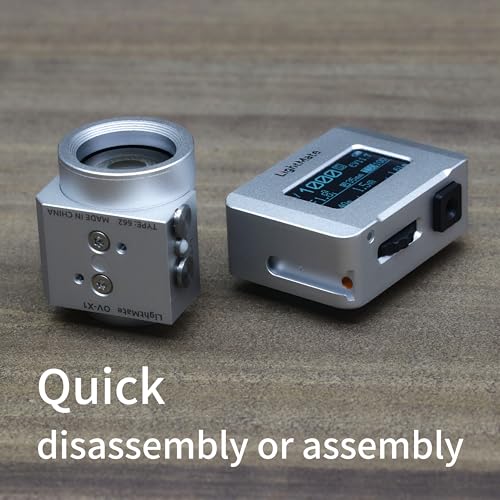
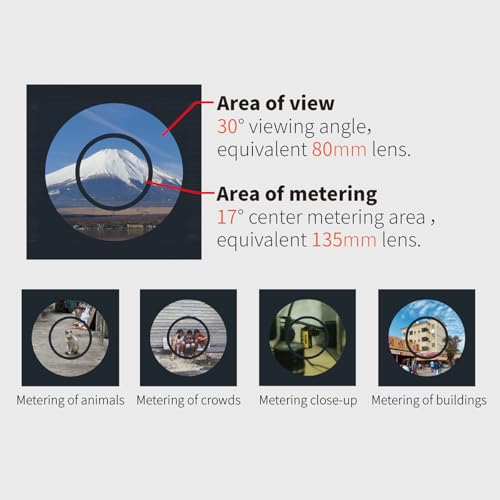
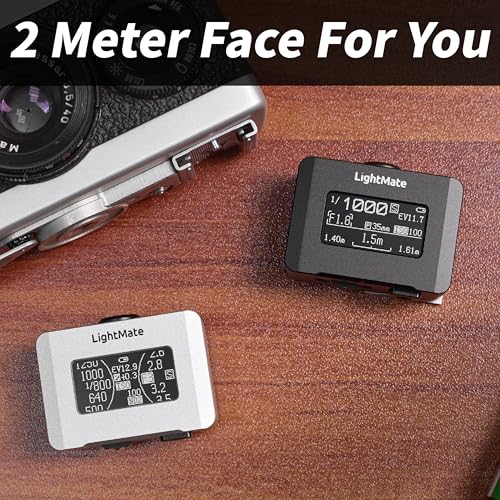
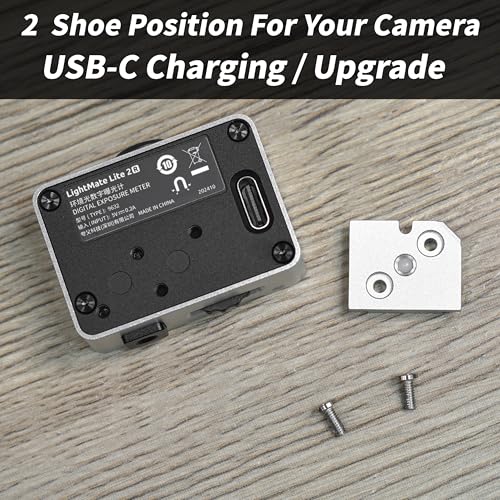
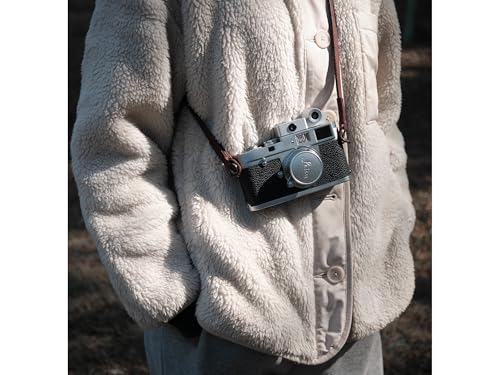
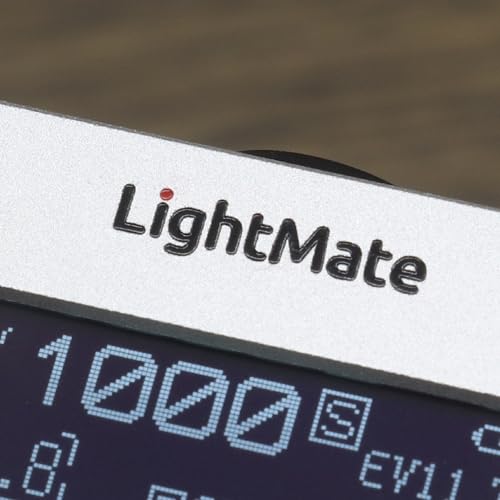
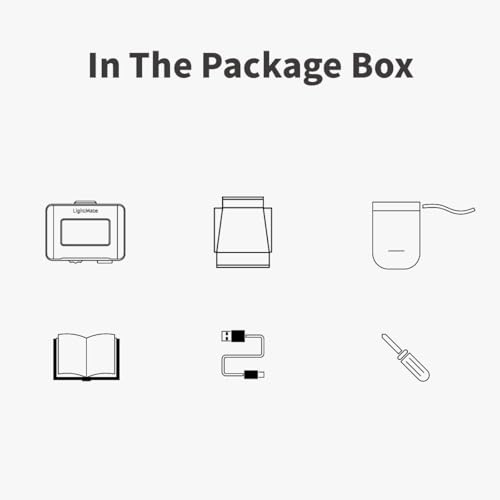
Picture this: you’re walking a bright street and your subject is backlit. The 17° OV‑X1 viewfinder lets you aim precisely, while single, continuous, and average modes help you tame tricky light. Aperture or shutter priority readouts map directly to your dials, so you set exposure fast and stay in the moment.
Perfect if you shoot classic rangefinders or SLRs, or want a compact backup for travel and documentary days. Mount it on the hot shoe to meter as you frame, or keep it in your pocket for scouting and pre-visualization between shoots.
You also get practical touches that accelerate your workflow: ND and exposure compensation, switchable step increments, and a digital depth‑of‑field tool for hyperfocal street work. The 0.96-inch OLED stays readable outdoors, and the USB‑C rechargeable battery runs for over 20 hours—great for weekend trips.
If you value portability, aimed readings, and fast manual setup, this pick delivers excellent everyday utility. Choose it as your travel meter or a dependable secondary tool, and enjoy cleaner exposures with minimal weight in your bag.
Digital Lux Meter Exposure Meter Alongwith Factory Calibration Certificate (Range: 0 to 4,00,000 Lux) for Auditoriums, Theatres, Stadiums, Labs
Photographers/videographers who need an inexpensive, calibrated lux meter for measuring continuous-light illuminance, validating studio and location lighting levels, or logging light readings for documentation.
- Wide lux measuring range (5 to 400,000 lux) suitable for bright daylight to dim indoor scenes.
- Factory calibration certificate included — useful for baseline accuracy and periodic verification.
- Cosine and colour correction filter on the photodiode, peak-hold, min/max memory and RS-232 data output for logging.
- Not a photography-specific exposure meter — no EV/aperture/shutter/ISO readouts or direct camera-setting guidance.
- No flash/TTL/flash-sync metering or dedicated flash sensor (cannot measure flash pulses or FP flash reliably).
This Ace Instruments Lux Meter is a good value for those needing a calibrated lux meter for continuous light checks, though it lacks features for detailed photographic metering.
Need hard numbers to dial in your lights? Ace Instruments Digital Lux Meter Exposure Meter Alongwith Factory Calibration Certificate (Range: 0 to 4,00,000 Lux) lands at #6 in our lineup with a 53/100 score for one simple reason: it gives you calibrated, wide‑range readings at a sensible price. If you want reliable lux data to plan and repeat lighting, this pick is a smart, budget‑friendly tool.






The 5–400,000 lux range covers everything from dim studios to sun‑blasted exteriors, so you can set interviews under LEDs, pre‑light auditoriums, or scout bright locations with confidence. A cosine and color‑corrected sensor aligned to CIE standards means the numbers you see translate to real‑world consistency when matching fixtures or manufacturer photometrics.
If you build continuous‑light setups, you’ll love using it to lock in key/fill ratios, validate client lux targets, and keep a consistent look across scenes. It’s also great for location scouts—estimate ND strength, choose ISO/shutter combos faster, and document baseline levels for permits or reports.
Peak hold, min/max memory, and a clear LCD make comparing fixtures and monitoring changes simple; the RS‑232 output lets you log readings over time for repeatable results. At around $174 with a factory calibration certificate included, it delivers professional accountability without the premium price tag.
Choose this option if you want calibrated, dependable lux data guiding your continuous‑light work. Pair it with your creative eye, and you’ll move faster, hit exposure targets with confidence, and deliver consistent results for clients and content platforms alike.
Light Meter or Lux Meter Exposure Meter Light Meterfor Auditoriums, Theatres, Stadiums, Labs Along with Factory Calibration Certificate Model LX-1102
Technically inclined users who need an affordable, calibrated lux meter for measuring ambient illuminance.
- Wide measurement range (40 to 400,000 Lux) covers weak to very bright lighting.
- Large, easy-to-read LCD with bargraph, plus peak-hold and data-hold functions.
- RS-232 data output and factory calibration certificate — useful for repeatable, logged measurements.
- Not a dedicated photographic exposure meter — no incident dome, no flash/peak flash metering, no direct EV/aperture/shutter readouts for given ISO.
- No user reviews or sales momentum (unknown reliability and support); brand is industrial-focused, not photo-specialist.
The INSTRUKART Lux Meter is suitable for ambient illuminance checks, though it lacks features for detailed photographic metering.
Need a reliable way to quantify your lighting on set? INSTRUKART Light Meter lands at #7 in our lineup with a 53/100 score because it delivers calibrated, repeatable readings at a fair price—great when you want consistent results without guesswork. If your workflow benefits from hard numbers, it’s an efficient tool to keep your lighting under control.

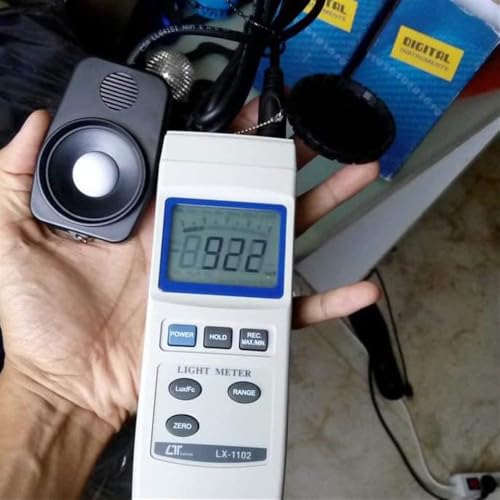
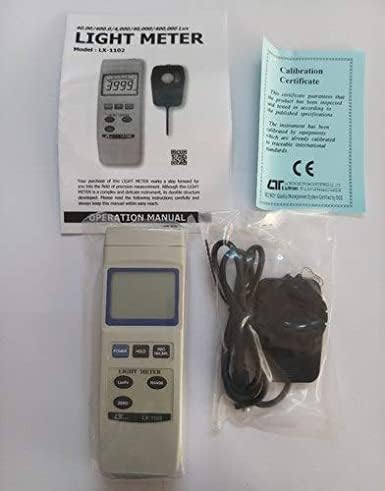
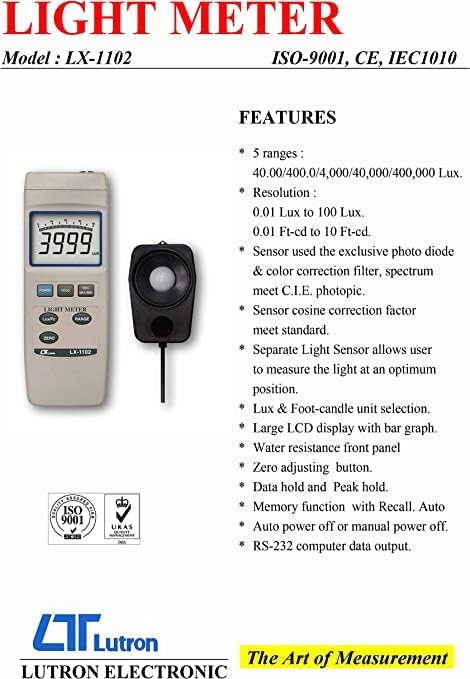
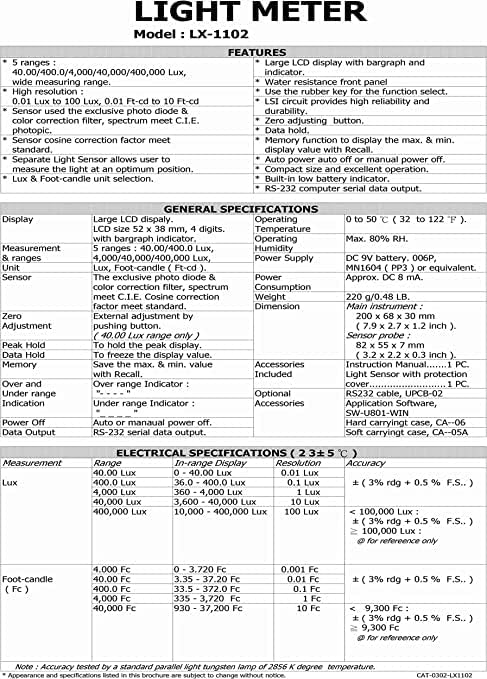
Picture this: scouting a dim theater one hour, then blocking a sunlit stadium the next. The wide 40–400,000 lux range covers both, while the large LCD and bargraph make trends easy to spot in real time. Peak hold and data hold help you capture quick spikes or freeze a reading so you can move and set your fixtures confidently.
Perfect if you like a data-driven lighting approach. Use it to baseline ambient levels for interviews, match scenes across rooms for real estate video, or document exposure targets for commercial sets. If you prefer converting lux to camera settings yourself and work mostly with continuous lights, this model fits right in.
What stands out is trust and workflow. A factory calibration certificate gives you confidence, and RS-232 output lets you log readings to build repeatable lighting notes across projects. The separate sensor, cosine correction, and max/min recall keep your measurements accurate, and at around $183, it delivers professional consistency without premium pricing.
If accuracy, repeatability, and simple logging matter to you, this pick is a smart buy. Choose it to standardize your lighting from prep to shoot day and cut down on trial-and-error. It’s a focused tool that pays for itself in fewer retakes and a smoother set.
Digital Lux Meter Exposure Meter Along with Factory Calibration Certificate (Range: 0 to 4,00,000 Lux)
Technically minded photographers/videographers who need an affordable, factory-calibrated lux/illuminance meter for measuring ambient light levels.
- Very wide lux range (5 to 400,000 lux) — can handle low indoor levels to bright outdoor light.
- Factory calibration certificate included — useful for someone who needs traceable readings.
- Photo-diode with color correction and cosine correction — improves photometric accuracy vs cheap sensors.
- AUDIENCE MISMATCH: Not a photography-first exposure meter — lacks incident dome, flash/TTL flash metering, EV/aperture/shutter/ISO display or cine-specific features.
- No reviews or sales momentum visible — hard to judge reliability/build quality in real-world photo/video workflows.
This Ace Instruments Lux Meter is a good entry-level option for ambient illuminance checks, though it lacks features for detailed photographic metering.
Need a trusted way to quantify the light on your set? This Ace Instruments Digital Lux Meter gives you calibrated illuminance readings from dim studios to blazing daylight, so you can light with confidence. It lands at #8 in our roundup with a 51/100 score for delivering dependable accuracy and strong value when you simply need true lux/foot-candle numbers.






Picture this: you’re matching key lights across multiple rooms, balancing a product table, or checking a stage wash before an event. The color- and cosine-corrected photodiode helps your measurements align with how the eye perceives light, while the wide 5–400,000 lux range and selectable ranges keep readings precise from soft tabletop setups to bright exteriors.
It’s perfect if you regularly verify ambient levels, ensure uniform lighting for catalog work, or scout locations and want repeatable, documented results. The included calibration certificate is great when clients or teams need traceable data for audits, rentals, or corporate shoots.
You also get practical workflow tools: max/min memory, peak hold for catching bursts, and a clear LCD with a bar graph to visualize changes at a glance. There’s serial data output for logging sessions, and at around $170, this pick brings calibrated accuracy that can pay for itself by reducing retakes and speeding setup.
If your priority is consistent ambient readings and proof you can share, this choice deserves a spot in your kit. Add it when you want simple, reliable light numbers to guide your exposure decisions and keep your photo/video work looking consistent from scene to scene.
Light Meter or Lux Meter Exposure Meter Light Meterfor Auditoriums, Theatres, Stadiums, Labs Along with Factory Calibration Certificate Model LX-1102
Technically inclined users who need a calibrated lux/illuminance instrument for measuring continuous ambient/stage/studio light levels.
- Affordable price for a calibrated lux/illuminance meter ($181) — fits the user’s stated budget range.
- Wide lux measurement range (40 → 400,000 lux) suitable for many studio, stage and location ambient-light scenarios.
- Photodiode sensor with CIE color correction and cosine correction — gives reasonably accurate illuminance readings for continuous light.
- Not a photographic exposure meter: no EV/f-stop/shutter-speed readout, no incident/diffuser dome, no flash/ttl/spot metering — key missing functionality for photographers/videographers.
- Basic, industrial-style lux meter features rather than photo/cine-centric workflows (no cine/shutter/fps/stop ratio tools).
This Ace Instruments Lux Meter is good for ambient/light-level diagnostics, though not recommended as a replacement for a dedicated photographic or cine light meter.
Need a fast, reliable way to measure ambient light on set? This Ace Instruments Light Meter (Model LX-1102) is our #9 pick, scoring 44/100 for its certified readings at a wallet-friendly price. It gives you consistent numbers you can trust when lighting studios, stages, and locations.
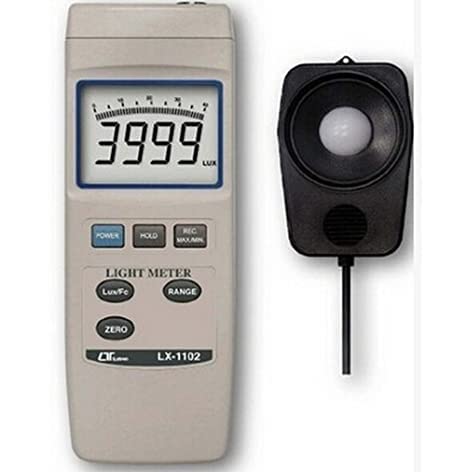
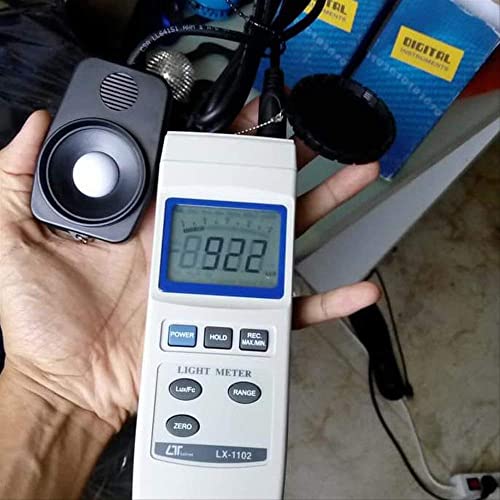
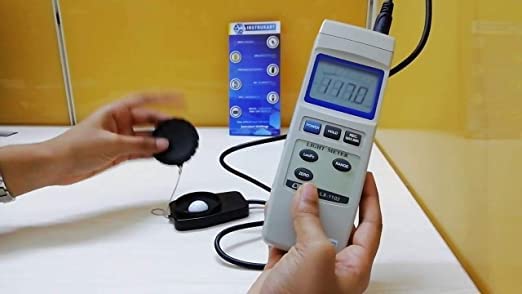
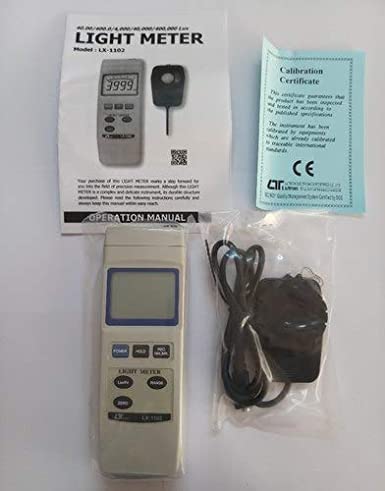
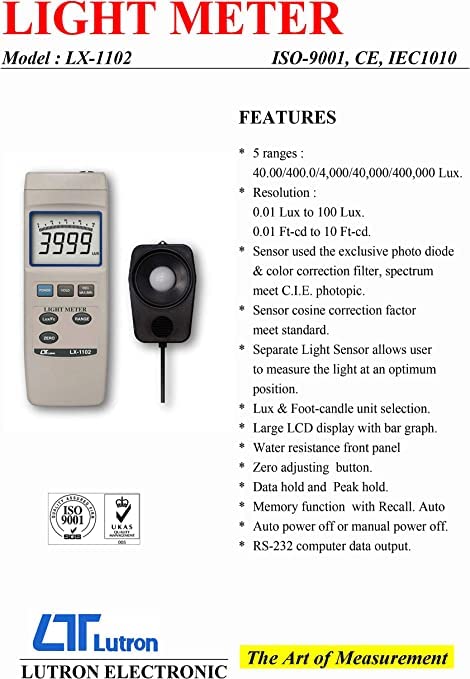
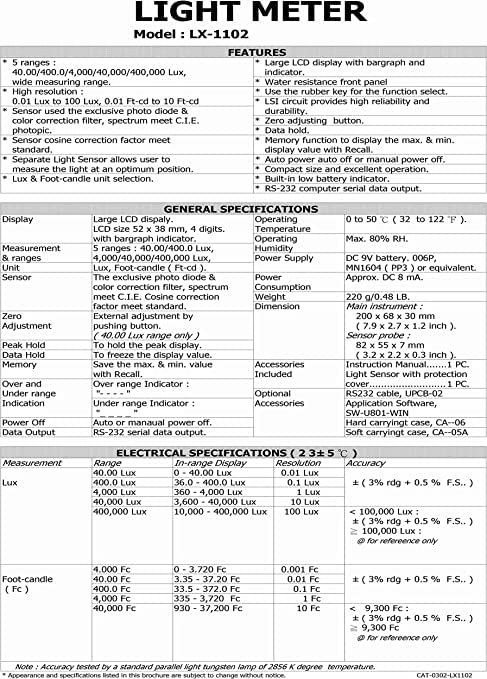
With a wide 40 to 400,000 lux range and a CIE/cosine‑corrected sensor, you get accurate measurements from dim rooms to bright sets. The separate sensor lets you read light right at the subject, and the large LCD with peak/data hold makes catching quick changes easy. Use it to map falloff, match scenes across days, or balance practicals with your key.
Perfect if you document venue lighting, prep theaters and auditoriums, or scout interiors before a shoot. If you’re filming interviews in conference rooms or dialing in studio ambience for talk shows and product videos, you can hit repeatable targets and keep ISO noise under control. It’s also handy for building a lighting playbook your team can follow.
Standout touches include a factory calibration certificate for peace of mind, RS‑232 output for logging readings, and simple 9V power for long sessions. The compact body and rubber keys make it easy to use on the go. At around $181, it offers calibrated performance without boutique pricing.
Choose this model when you want dependable illuminance data to standardize setups, speed up lighting, and keep clients confident. Use it alongside your camera settings or dedicated exposure tools to turn target lux into consistent results. If consistency and documentation are priorities, this is a smart addition to your kit.
When you buy through links on our site, we may earn a commission at no cost to you. We evaluate products independently. Commissions do not affect our evaluations.
Making Your Final Choice
We analyzed and compared nine light meters for 2025 and ranked the Sekonic Sekonic L-308X-U Flashmate Light Meter (401-305) as our top pick (76/100). It balances accurate incident/flash readings and practical cine modes in a pocketable body, while our Best Value, the Sekonic Sekonic FLASHMATE L-308X Photographers and Film Ma… (64/100), delivers the core essentials for less.
For studio portraits, products, or fashion with strobes, pick the L-308X-U to meter flash, nail ratios, and keep sets moving. Location/event shooters and hybrid videographers will appreciate its fast ambient/flash switching and cine readouts (fps and shutter angle) for consistent exposure across mixed lighting.
If you work only with continuous light or need a scouting tool, consider the LATNEX LATNEX Light Meter LM-50KL Mea… (60/100), LightNova LightMate Area 2S Light Meter … (54/100), or Ace Instruments/INSTRUKART lux meters. They’re fine for validating LED levels, but they lack flash metering and camera-centric controls, so we’d keep them as secondary meters.
Only one meter in our list cleared 70+ this year, and it’s the L-308X-U. Check live pricing and availability via our trusted retailer links, then choose with confidence.
Disclosure/Disclaimer: As an Amazon Associate, we earn from qualifying purchases. Certain content was provided "as is" from Amazon and is subject to change or removal at any time. Product prices and availability: Amazon prices are updated daily or are accurate as of the date/time indicated and are subject to change. Any price and availability information displayed on Amazon.com at the time of purchase will apply to the purchase of this product.





